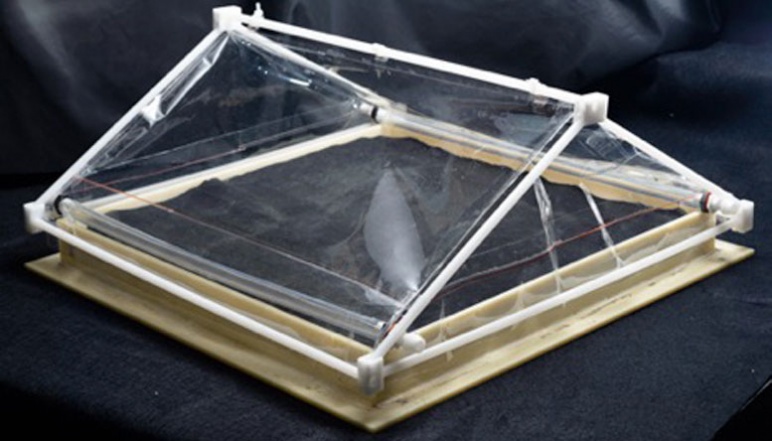Our Research Floating, heat localizing solar receivers for distributed desalination

Photo Credit: Chen research team

Photo Credit: Chen research team
Principal Investigator
Gang Chen
- Carl Richard Soderberg Professor of Power Engineering
- Director, Pappalardo Micro and Nano Engineering Laboratories
- Director, DOE EFRC: Solid-State Solar-Thermal Energy Conversion Center (S3TEC)
- Department of Mechanical Engineering
Gang Chen is currently the Carl Richard Soderberg Professor of Power Engineering at Massachusetts Institute of Technology (MIT). He served as the Head of the Department of Mechanical Engineering at MIT and as the director of the Solid-State Solar-Thermal Energy Conversion Center, an Energy Frontier Research Center funded by the U.S. Department of Energy. He received an NSF Young Investigator Award, an R&D 100 award, the ASME Heat Transfer Memorial Award, the Frank Kreith Energy Award, the Nukiyama Memorial Award by the Japan Heat Transfer Society, a World Technology Network Award in Energy, an Eringen Medal from the Society of Engineering Science, and the Capers and Marion McDonald Award for Excellences in Mentoring and Advising from MIT. He is a fellow of the American Academy of Arts and Sciences, the American Association for Advancement of Science, APS, ASME, and the Guggenheim Foundation. He is an academician of Academia Sinica and a member of the U.S. National Academy of Engineering.
Photo Credit: Tony Pulsone
Challenge:
Can we design small-scale solutions for water supply that target locations where desalination or water purification needs coincide with abundant solar resources?
Research Strategy
- Design a floating solar evaporation system using low-cost materials
- Research water needs and economic impact potential in the Maldives
- Investigate technology for use in wastewater treatment and evaporation ponds
Project description
Freshwater is an increasingly scarce resource to human society, with many regions around the world facing droughts. Increasingly, communities are turning to seawater desalination to satisfy growing freshwater demand. However, current desalination technologies are not available to all populations; large operational scales and reliable infrastructure are needed to economically run established desalination technologies such as reverse osmosis (RO) and multi-stage flash (MSF). Small populations, distributed populations, and economically challenged regions do not have the technology and financial backing to utilize these desalination technologies.
This project aimed to provide a scalable, low-cost floating solar desalination technology by capitalizing on a recent invention by the PI that achieved high evaporation rates and high efficiency. The PI previously developed a floating solar structure that absorbs sunlight and heats a confined layer of water at the water-air surface, which enhances evaporation over natural rates. This work had high promise in diverse industries from desalination to wastewater management. In this project, the research team targeted desalination by condensing the generated vapors into distilled drinking water by developing a wavelength-selective, insulating, solar powered still (WISPS) tarp structure that can float on and cover ocean, lake, and pond surfaces to extract freshwater from the waters underneath. This structure integrated several characteristics: spectral selectivity (high solar absorptance and low thermal emittance), thermal insulation, thermal concentration, low cost, and salt-repelling anti-fouling construction. It is easy to install, and is made with commercially available materials. The bill of materials cost was estimated to be $3per m2(~1.5 m3of water per year), compared with $38-$300 per m2for traditional solar stills. This size of WISPS can produce enough daily drinking water for individuals, making WISPS an attractive desalination option for distributed communities in close proximity to bodies of water. At the conclusion of this project, a scalable, portable, and low-cost desalination unit was demonstrated. The future steps for this project are to identify willing entrepreneurs to commercialize and deploy the systems to needy regions.
Outcomes
- Developed a new, floating, evaporation structure that can absorb and convert incident solar flux (nominally 1 kWm-2, 250-2500 nm) into thermal energy, and transfer the heat to water for vapor generation, while rejecting excess salts. The structure includes a low-cost polymer cover for improvement in collection efficiency
- Conducted a research trip to the Maldives where market research was collected and key stakeholders were mapped. With the evaporation structure's predicted $1.5 per m3 water production cost, it could offer value by providing cheaper water, with the ability to control water production during droughts and emergencies without relying on governmental aid
- Conducted research in regards to 700+ wastewater ponds in California and found that fouling is a major issue due to high salinity. The designed evaporation structure was shown to prevent fouling by alternating layers of white cellulose fabric and expanded polystyrene foam that simultaneously achieve salt rejection and thermal insulation
Publications
A salt-rejecting floating solar still for low-cost desalination
George Ni, Seyed Hadi Zandavi, Seyyed Morteza Javid, Svetlana V. Boriskina, Thomas Cooper, Gang Chen, Energy & Environmental Science, 2018
News
Additional Details
Impact Areas
- Water
Research Themes
- Water Purification & Desalination
- Technology & Commercialization
- Equity & Access
Year Funded
- 2016
Grant Type
- Solutions Grant
Status
- Completed


